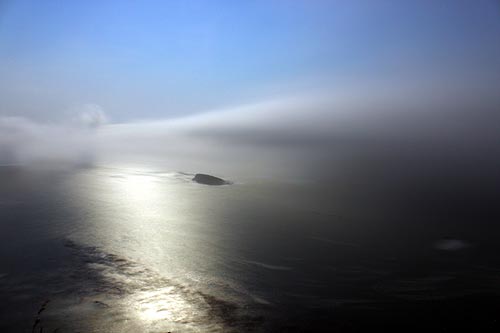 |
Aurora Lights and Blue Moon for Inland Oregon, Portland, Coast; Video
Published 07/03/2015 at 4:34 PM PDT
By Oregon Coast Beach Connection staff

(Portland, Oregon) - Two exciting events in the skies above Portland, inland Oregon and the coast this month, and one is probably happening right now. According to Jim Todd, astronomy expert at Portland's OMSI, we have two blue moons this month and the distinct possibility of northern lights tonight, visible this far south.
Meanwhile, Venus and Jupiter will still be bright and fairly close together for the next few days as well. See the timelapse video of that on the Oregon coast this week below, as well as the light of the first Blue Moon moving on the waters of Manzanita.
Todd said an extreme geomagnetic storm is happening right now (at Kp9), which means the higher latitudes like Canada and Alaska have a very high chance of seeing the Aurora Borealis, while lower latitudes like Oregon have a really good chance.
The current sun storm is of a very high magnitude, according to SpaceWeatherLive.com. Which means those of you on the Oregon coast for the holiday weekend may get an even better light show if you look to the north. It's advisable to use a camera on a tripod, as the human eye does not always catch this.
However, in Oregon, the moon is still substantially large and bright until the wee hours, so it's best to look northward around 2 a.m. or 3 a.m. or later.
There was already one full moon, and another is coming this month – making both the Blue Moon. This is what's in store for Portland, inland Oregon and the Oregon coast.
Todd said this one on July 1 became full at 7:20 p.m., and the next is on July 31 at 3:43 p.m. A blue Moon occurs every three to four years, when the date for one full moon falls on or near the beginning of a calendar month so that the following full moon comes before the end of the same month.
The term “blue moon” has multiple meanings, Todd said. Having been in use for some 400 years, during that time its meaning has shifted around a lot.
“More recently, the term was cited in The Maine Farmers' Almanac, 1937,” Todd said. “The almanac states that when there were two full moons in a calendar month, calendars would put the first in red, the second in blue.”
In the realms of astronomy, Todd said “blue moon” is the second full Moon to appear in a single month. But in meteorology, the actual definition is when a moon literally appears to turn blue. The Moon can do this for a number of reasons, but the two more common circumstances involve a cold night or smoke.
“The Moon can also has a bluish color on very cold winter nights when ice crystals in the air form of a ring around the Moon,” Todd said. “The scattering of moonlight by smoke particulate causes a 'blue moon.' The red end of the spectrum is scattered more than the blue end of the spectrum, which causes light seen from the Moon to look more blue: hence, a blue moon.”
Despite the differences in meaning, in general terms, the rarity of seeing a moon that looks blue and/or the rarity of two full moons appearing in one month prompted the well-known saying "once in a blue moon," which means something that happens very rarely.
The last blue moon occurred in August 2012, and the next will be in January 2018.
#OregonCoast Video: Planets Converge Above Manzanita; Stars, M...#OregonCoast Video: Planets Converge Above Manzanita; Stars, Moon Moves on Water. #Oregon #northwest #portland #eugene #astronomy
Posted by Oregon Coast Beach Connection on Thursday, July 2, 2015




More About Oregon Coast hotels, lodging.....
More About Oregon Coast Restaurants, Dining.....
LATEST Related Oregon Coast Articles
Decay Hits Beloved Oregon Coast Tree, Now the Newport Icon Must Be Cut Down |
Back to Oregon Coast
Contact Advertise on BeachConnection.net
All Content, unless otherwise attributed, copyright BeachConnection.net Unauthorized use or publication is not permitted
Secrets of the Season |
Unusual Travel Articles TravelParanormal.com allows you to submit your own creepy tale or debunk one - or see up-to-the-minute news headlines about travel and the paranormal. News Headlines from All Over Oregon Need to scan Oregon headlines? Constantly updated news from all over Oregon: a comprehensive, up-to-the-minute display of news headlines from a variety of media Oregon Coast Oceanfront Lodging, Hotels, Rentals |







































